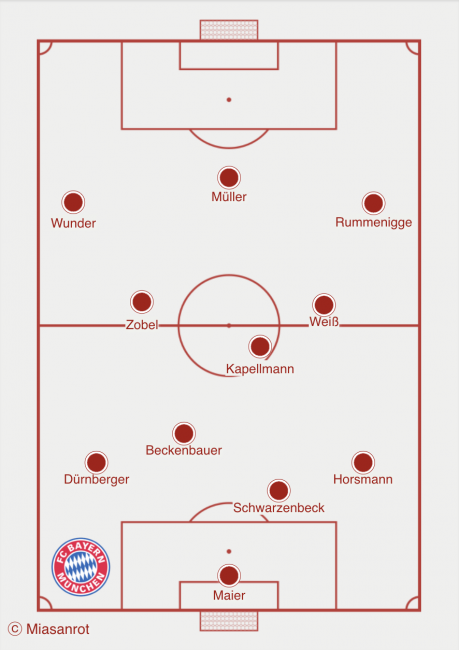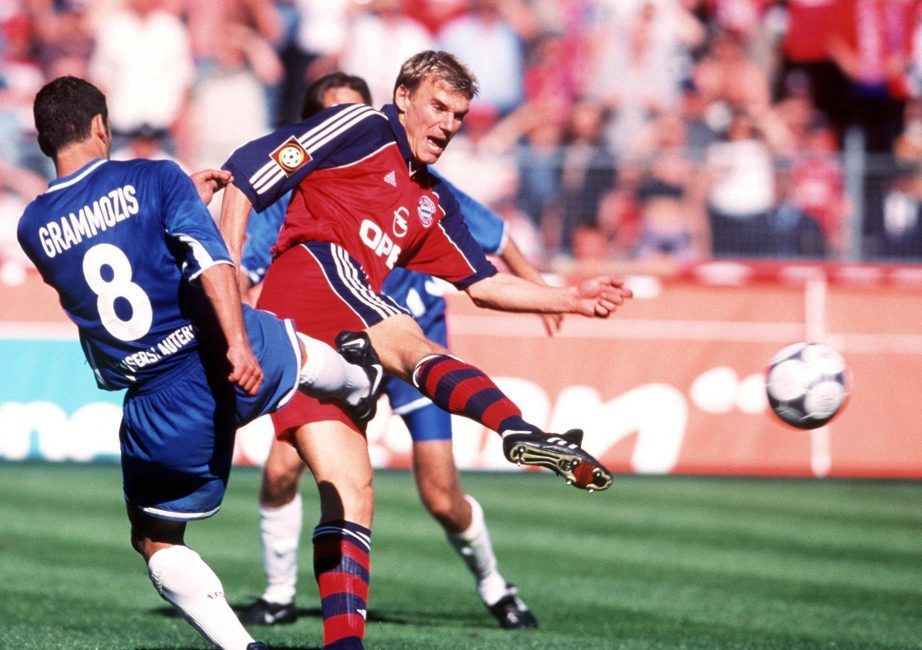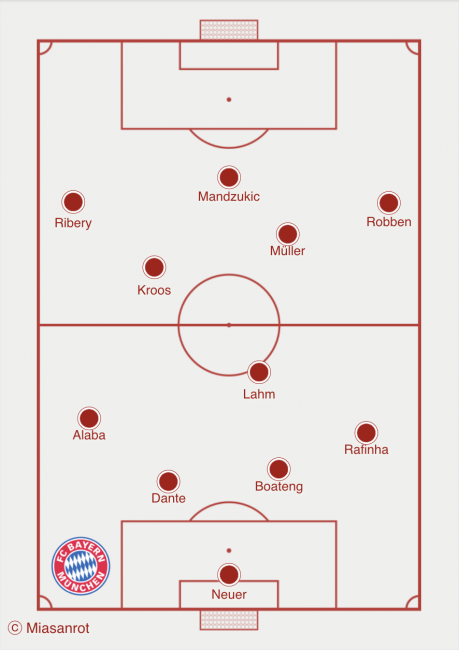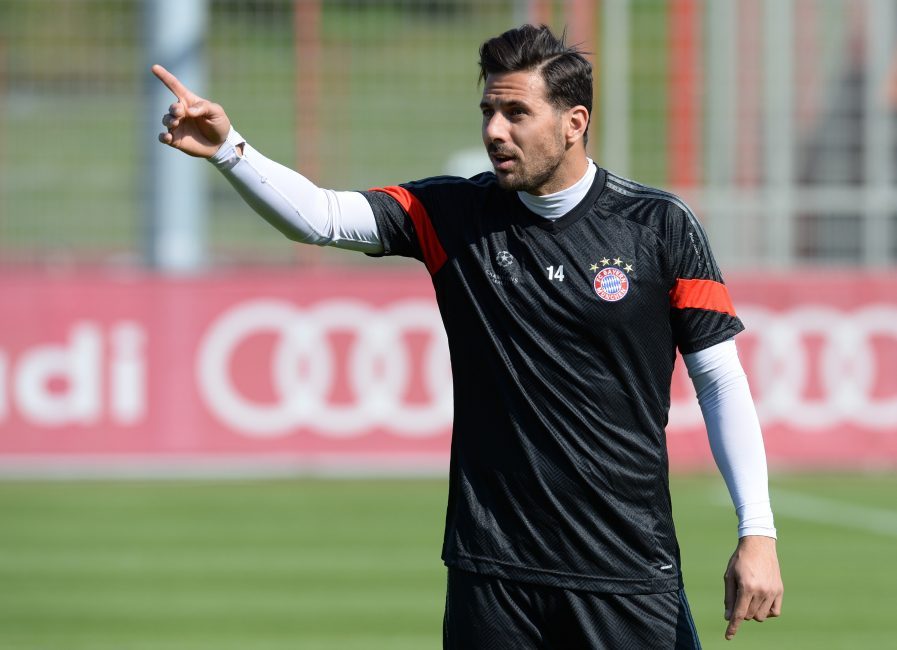Stats & Links: Shadow strikers over time
Since the question regarding the necessity of one or even several replacement strikers varies with the playing system of a club – i.e. lone central striker or two up top – we want to go up through the decades one hand after another, using the question of the system as our basis.
The back-up from the wing
Similarly to nowadays as well, in the 1960s and 1970s there was also only one central striker and like today that central attacker was world class. The bomber Gerd Müller was unchallenged.
In the early years – here is the first difference to today’s situation – rotation was uncommon. If Müller was fit, Müller played. Only suspensions or injuries to the bomber could see a replacement get a chance.
It was obviously impossible to attract a second top-class striker with that job description. In addition to that, the sizes of the squad at the time weren’t fit for such a double occupation, nor could the Rekordmeister have afforded a player of such class just for the bench.

So you looked to the wings for an alternative. In the 4-3-3 system common at the time, you could push a second or third central striker towards the left or right. The wide striker wasn’t so rigidly fixed in his role back then. Alongside the typical dribbler on the flank there were also always incognito strikers whose actual strengths lay in the penalty area.
Correspondingly, many different types played on the Isar too: the current chairman Rummenigge as an actual central striker who was, however, able to invigorate the flank with his speed and dribbling skills; a prototypical wing-back like “Wipf” Dürnberger, and also the current president Hoeneß, who in his interpretation was rather more like a Robben or Ribery of today.
For Rummenigge, that was a happy accident. In Müller’s shadow he was able to come of age without, however, having to oust him. From a young age he got more and more game time, and was able to play freely without having the rough central defenders of the opposition standing on his feet.
A change to two up top
A change in system came for the first time under Pal Csernai. The Hungarian established a 4-4-2 system in Munich. Coincidentally this was much to the chagrin of a certain Calle Del’Haye, who was brought in as a wide striker in the 4-3-3 and now had to acknowledge that his position simply didn’t exist anymore.
From the end of the 70s until 2009, Bayern now played, aside from a brief time under Lattek, with two up front.

The effect on the occupation of the attacking squad places and on the roles intended for the strikers in this new system was huge. Instead of a clear number one striker and a back-up who was right at the bottom of the hierarchy and only managed sporadic appearances, a system with two strikers demanded another central striker of stature.
There was often no clear ranking of these two strikers, or it was at least not set in stone and dependent on the performances shown. As well the role of the back-up, the third striker then, was enhanced in that his chances of getting onto the pitch had in a way doubled. Finally, only one of the two regular strikers had to miss out for the number three to get into the team.
With these increased chances of playing, the fluctuation in the squad and especially up front was also clearly increased. In seeking the big time, a variety of strikers were worn out (among others Lars Lunde, Johnny Ekström, Alan McInally, Mark Hughes, Radmilo Mihajlovic, Jürgen Wegmann, Brian Laudrup, Bruno Labbadia, Adolfo Valencia, Marcel Witeczek, Jean-Pierre Papin, Emil Kostadinov, Alain Sutter, Ruggiero Rizzitelli). Ultimately other than Roland Wohlfahrt none of them truly asserted themselves.
The type of striker specifically that could have made the grade at Bayern Munich was generally secondary. A common denominator of Mark Hughes, Mazinho, and Alexander Zickler is still being sought today. Rather the only requirement made of a potential new striker in Munich was that he should guarantee 15 goals a season.
The premium super-sub Alexander Zickler scores probably his most important goal for FC Bayern on the 33rd matchday in the 2001 season.

(Photo: Michael Kienzler/Bongarts/Getty Images)
At the end of the 90s, when the then-novel concept of rotation spread and as a result teams’ squads became bigger, a fourth striker even came into play. The pioneer on the Isar here was Ottmar Hitzfeld, even though in his first season in 98/99 he still set up his team in a variable way, often moving away from the system with two up top in deploying players like Basler, Scholl or Salihamidzic as wide strikers.
In the mid-term, however, the following principle took hold: there was a first-choice striker, two more or less equally strong strikers, and one talent with opportunities as a maverick. The great advantage of that logic was that the talent didn’t absolutely have to get past the multi-million-euro striker to get game time or a place in the first eleven. That guaranteed high permeability from bottom to top.
The high number of squad places also led to permanent upgrades up front. Klose or Toni quickly became Klose and Toni. And Podolski.
EURO 2008 as sea-change
The final of the 2008 European Championships saw Spain and Germany face off in Vienna. On this biggest of possible stages, both teams went without a second striker, and operated in a 4-5-1 and 4-2-3-1 system respectively. This was a system that would quickly find its way into club football after this Euros.
It was only a matter of time, then, before this system was also established on Säbener Straße. That point had come in 2009 when Arjen Robben moved to FC Bayern and Louis van Gaal, indeed a proponent of 4-3-3, had a real flank pincer at his disposal. With just one central striker left on the pitch, the game time of the squad’s four strikers obviously had to drop.

Eventually Gomez came out on top and was rewarded for his persistence in that the competition for the one striking position clearly weakened. FC Bayern’s squad planners had realised in the mean-time that the change to a one-striker system was apparently going to last. As a result, Petersen came in before the 11/12 season as a clear back-up.
But after just one season that approach was scrapped again. After the loss in the Champions League final of 2012, Uli Hoeneß criticised Gomez publicly as merely a good striker – with a very good striker, on the other hand, the Champions League could have been won.
To heat up the competition, Mandzukic was brought in during the summer of 2012 after his strong Euros for Croatia, with Pizarro also returning to Munich. Neither were planned as guaranteed starters, and were mostly brought in because the lack of depth in the squad was seen as a key reason for the trophyless season in 2011/12. But due to an early injury to Gomez, the Croat managed to push past the German international and nail down a starting place, making Gomez the back-up.

(Photo: Christof Stache/AFP/Getty Images)
When Gomez as a result left the club in the summer of 2013, the position of back-up striker wasn’t occupied at all. Since Guardiola wasn’t an advocate of a pure central striker anyway, he preferred to use flexible players like Götze or Müller in the role of a “false nine”, with Claudio Pizarro remaining the only “genuine” replacement striker.
In the end, mostly seen in his training kit at FC Bayern: back-up striker Claudio Pizarro.
For the 2015/16 season, even that squad place was economised. Robert Lewandowski emerged as a very robust player hardly susceptible to injury who also always wanted to play. In the previous season Pizarro had hardly gotten any meaningful minutes, and so the post of back-up striker, for the first time in FC Bayern Munich’s history, became vacant.
Until the signing of Sandro Wagner.
Only a few convinced
How have FC Bayern’s back-up strikers fared over the years?
The most successful of all of them was certainly Roland Wohlfahrt, who from 1984 to 1993 went into the season as a back-up year on year, and yet almost always ended the season as a key player and the first-choice striker. Up until the 1991/92 season, he managed to score double figures every year – twice he was even the top scorer.
In spite of that, at least one new striker was regularly plonked in front of his face in the summer break. Wohlfahrt lacked flair and star potential, and was considered too plain for Säbener Straße. And yet 119 goals in 254 Bundesliga appearances underline the enormous value that Wohlfahrt had for the club as the only constant up-front over a decade. And alongside that he’s also proof that not every Bayern starter automatically gets a national call-up.
Alexander Zickler should also get a special mention here: he was the premium super-sub of the late 90s and early 2000s. Until two years ago, the German international with 12 caps to his name still held the record for the most goals scored by a substitute, with 18 goals in 102 sub appearances.
Above all, Zickler didn’t manage more than that because of injury. Whenever it seemed like he would finally make the breakthrough and nail down a starting place, he got injured. The beginning of 2000 is given as the prime example, when he managed five goals within three weeks in the Bundesliga, and he also netted twice in 16 minutes against Real Madrid in the Champions League. In the meaningless final group game against Dynamo Kiev, however, he got a bad injury and was out for the rest of the season.
The main reason for the long-unsuccessful search for a striker in the 80s and 90s was that there seems to have been no defined profile of the requirements. Now it’s Sandro Wagner’s turn to don the role.
As a striker, Wagner’s physique marks him out, especially in the penalty area. For the majority of his career, that was his calling card. In Nagelsmann’s system in Hoffenheim, however, the new German international showed other, unforeseen qualities in positional play. He was constantly available as a reference point and a pivot, knew how to hold the ball up and smartly play it on.
Especially that last quality can also be of help to him at Bayern in getting game time. Whether Müller this season or Götze in previous years, both were unable to act as that pivot in fast attacks. What’s more is that Wagner can occupy the centre better than both of those players, and has a more than passable heading game.
If Lewandowski gets more breaks, then, Wagner is certainly a suitable replacement for him. A fitting candidate seems to have been found for the profile of requirements. With two goals in his first five games, Wagner also underlined his qualities in front of goal.
Links of the week
How does Pep Guardiola feel about his ambassador role for Qatar World Cup? | Richard Williams | The Guardian
Arjen Robben’s sharp decline should ring an alarm bell at Bayern | BayernCentral
Taking ‘Em On: Digging Deeper With Dribbles | Euan Dewar | Stats Bomb
Is rotation the enemy of perfection for Bayern Munich after Besiktas rout? | Raphael Honigstein | ESPN
Arjen Robben’s Bayern Munich considering MLS, China or Qatar move | Mark Lovell | ESPN
Current Miasanrot-articles
Are FC Bayern Champions League contenders? | Marc
FC Bayern Reserve – VfB Eichstätt 2-0 (1-0) | Martin
3 Things We Noticed: FC Bayern – Hertha BSC 0-0 (0-0) | Maurice




 February 28, 2018
February 28, 2018 



